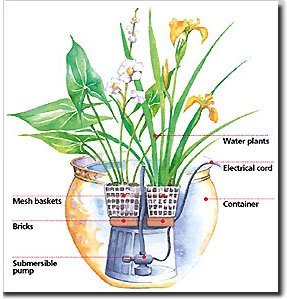When it comes to pond plants for your container water garden, there’s a lot of choice. Plants suitable for water gardens, containers or ponds, are readily available at well-stocked garden centers.
These plants are easy to grow and need little maintenance, aside from occasional cutting away of yellowing foliage or spent flowers.
How to arrange your water plants

Container garden with pond plants
Pond plants can be floaters, such as water hyacinth, water lettuce or duckweed, or they can be true aquatics, such as water lilies.
The third option is marginals, so called because they grow in wet soil at the waterside or margin of the pond. Water iris, taro, water canna and calla lilies are good examples.
To make your pond-in-a-pot look good, go for interesting foliage contrasts. For example, you could set an upright-growing spiky-leafed pond plant, such as water iris, beside the bold foliage of a red-leafed taro plant or spotted-leafed calla lily.
Adding a water lily
To grow a water lily, place your container water garden where it will get at least six hours of full sun.
Choose a dwarf variety – larger ones can cover the entire surface area. Even dwarf varieties take up a good deal of space and you’ll only be able to accommodate a single one in your pot.
To fill out the planting, add compatible floaters such as water hyacinth or water lettuce.
Keeping algae growth down
Filling your container with plants so that 75 to 80 percent of the water surface is covered keeps algae growth down. And adding one or two underwater oxygenating plants such as pondweed helps maintain clarity of the water.
Most full-service garden centers have water garden sections, and the staff can advise you on plants that will work best for your container water garden.
How to pot pond plants
Transplant water plants from their plastic nursery pots into open, plastic mesh baskets, available in various sizes at water garden suppliers.
To prevent loose soil from clouding up the water, line mesh pots with porous landscape fabric cut to size. Use clay pond soil (available from water garden suppliers) and top the soil with a layer
of pea gravel.
Plant so the crown – where the leaves emerge from the roots – is just above the soil surface. At planting time, add a long-lasting fertilizer tab to each pot (use only fertilizer intended for water gardening). Set the container so that its top is even with the water level.
What to do at the end of the season
At the end of the season, you can either treat the plants from your water garden as annuals or store them for reuse next year.
To keep them, cut back foliage and, leaving plants in their mesh baskets, place them in a plastic pail with a little water, cover the whole thing into a plastic garbage bag and store in a cool, frost-free place.
Drain the water container and scrub it clean. You can keep it in a shed or garage, but if the container is particularly costly or frost-sensitive, keep it inside.
This easy water garden project is about the quickest way I know to get started with water gardening. We especially like hearing the sound of water when we’re relaxing on our patio in the evenings.
More garden tips
Mosquito control for water gardeners
Safe water gardening: Prevention tips for West Nile disease








